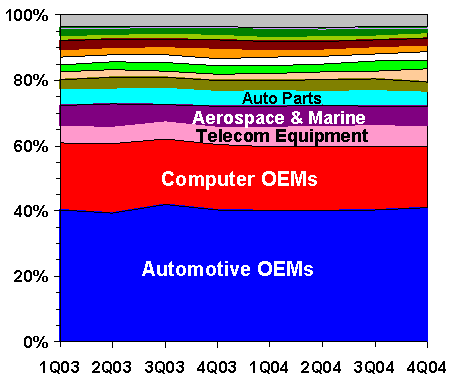May 10, 2005 |

|
ISSN 1550-9214 |
Warranty by Industry Sector:While claims grew by 4.9% to $25.1 billion in 2004, warranty's slice of revenue actually shrank a bit as sales grew faster. In some industry sectors, both dollars and percentages actually fell, but computer and automotive OEMs still process the vast majority of all warranty claims.American manufacturers paid out $25.1 billion, or 1.8% of their product sales in 2004, to honor their worldwide warranty claims, according to data provided by the manufacturers themselves in their annual reports. However, just a handful of manufacturers accounted for half that total, and only two types of manufactured products together accounted for 60% of the pie. The universe of manufacturers can be divided up in any of numerous ways. The government slices them up by Standard Industrial Codes (SICs), but those categories seem somewhat antiquated and convoluted (for instance, IBM and HP make "computers and office equipment" while Dell and Apple make "electronic computers."). Unisys is listed as a service company. Furthermore, the SICs are assigned based on what the companies sell, not what they warrant. So a lumber company that also builds warranted homes is listed under "lumber and wood products (no furniture)" and a carpet and countertop manufacturer is listed under a heading for plastic, rubber, and resin. There are also some weird mixes of unlike companies in the same SIC. A company that makes lawn mowers is in the same SIC as one that makes boat engines and another that makes turbines for power plants. $1.4 Trillion in Warranted Products?Numerous manufactured products are not normally covered by express warranties (for instance food, pharmaceuticals, and apparel), nor are most raw materials, minerals, or chemicals. After completing our analysis of 2004 warranty spending, we're going to guesstimate that roughly $1.4 trillion worth of products manufactured in the U.S. are covered by product warranties. That would be something like 12% of the gross national product, plus or minus one or two percent. What we need is a categorization system for just that 12%. We don't need categories for all manufactured products -- just those that are sold with warranties. We don't need endless categories for financial services, telecommunications services, energy, food, or pharmaceuticals. All we need are a few categories for the major providers of product warranties. What we've done is to divide the relevant universe of manufacturers into 14 sectors:
And then there is the all-purpose "other" category which includes everything from wristwatches to mining equipment. It also includes electrical power turbines, conveyor belts, farming machinery, food processing systems, oil and gas equipment, and other materials handling apparatus that don't easily fit into either the automotive or the building materials categories. And it includes all manner of eyewear, pens, sporting goods, camping equipment, and specialized clothing that doesn't fit into the electronics or appliance categories. No Splitting CompaniesNumerous companies would qualify for two or more categories. However, since they don't divide their warranty expenditures by division or product line, neither will we. Nor will we try to extrapolate from their revenue segmentation what portion of their warranty claims arises from each line of business. Instead, we will place each manufacturer into one and only one category, taking into account what warranted product line dominates their sales totals. Therefore, we're consigning United Technologies to the aerospace category, in spite of their major presence in HVAC and appliances. American Standard, meanwhile, is going into the HVAC category because of the dominance of Trane, despite the company's presence in plumbing and other lines of business. Honeywell, Brunswick and Textron go into aerospace and marine. Motorola goes into telecommunications equipment. And Eaton goes into auto parts suppliers. General Electric, which by the way is the sixth largest U.S.-based warranty provider, could easily fit into either of four categories: appliances, aerospace, HVAC, or medical equipment. Whichever category it goes into, it would dominate, being the #1 or #2 warranty provider. However, the company reports that most of the $838 million it reported in 2004 claims arose from sales of electrical power turbines (its "energy" segment). Therefore, we're going to place it in the "other" category, where in fact it accounts for just under 90% of the sector's total. With all that in mind, here is the warranty track record of these 15 sectors over the past two years. The vertical scale is in percent, while the horizontal scale spans the eight quarters of 2003 and 2004. What's fairly clear is that not much has changed. Automotive and computer OEMs continue to dominate. Manufacturing Industry Sectors | |||||||||||||||||||||||||||||||||||||||||||||||||||||||||||||||||||||||||||||||||||||||||||||||||||||||||||||||||||||
| Warranty | Warranty | |
| Claims $m | Claims $m | |
| Industry Sector | 2003 | 2004 |
| Automotive OEMs | $9,630 | $10,148 |
| Computer OEMs | $4,869 | $4,870 |
| Telecom Equip | $1,333 | $1,662 |
| Aerospace & Marine | $1,401 | $1,434 |
| Auto Parts Suppliers | $1,237 | $1,259 |
| Semiconductors | $523 | $694 |
| New Homes | $570 | $668 |
| Building Materials | $663 | $730 |
| Medical & Scientific | $558 | $611 |
| Data Storage | $652 | $589 |
| HVAC/R | $419 | $466 |
| PC Peripherals | $549 | $505 |
| Major Appliances | $436 | $461 |
| Cons Electronics | $106 | $105 |
| Other | $1,016 | $937 |
| All U.S. Mfgs. | $23,964 | $25,139 |
Overall, the total for warranty claims in 2004 was up by $1.175 billion, or 4.9%. But within that total there were some very large increases. Telecom equipment manufacturers saw claims rise by almost 25%. Semiconductor manufacturers saw claims rise by just under 33%. The builders of new homes paid out 17% more in 2004 than they did in 2003.
Spending by automotive OEMs was up by 5.4% in dollar terms. Spending by computer OEMs was up by only 0.02%. Spending by disk drive and PC peripherals manufacturers was actually down from one year to the next.
While the dollar totals are interesting, what means more is the percentage of sales that each dollar total represents. In several sectors, the dollars spent to honor warranty claims increased, but the percentage of revenue spent on warranty decreased. This of course happened because revenue grew faster than costs.
For instance, in the medical and scientific equipment sector, manufacturers spent 9.4% more on claims, but the share this represented dropped from 0.91% to 0.90% of sales. It's rounded off in the chart below so it appears there was no change. But the data does show a notable change in the rates for computer OEMs, data storage, new homes, PC peripherals, and semiconductors.
Manufacturing Industry Sectors
Warranty Claims Rates as % of Sales
2003 - 2004
| Warranty | Warranty | |
| Claims % | Claims % | |
| Industry Sector | 2003 | 2004 |
| Automotive OEMs | 2.6% | 2.5% |
| Computer OEMs | 3.5% | 3.1% |
| Telecom Equip | 1.4% | 1.6% |
| Aerospace & Marine | 1.3% | 1.2% |
| Auto Parts Suppliers | 0.6% | 0.6% |
| Semiconductors | 1.8% | 1.5% |
| New Homes | 0.9% | 0.8% |
| Building Materials | 0.8% | 0.8% |
| Medical & Scientific | 0.9% | 0.9% |
| Data Storage | 2.8% | 2.2% |
| HVAC/R | 1.2% | 1.2% |
| PC Peripherals | 1.7% | 1.4% |
| Major Appliances | 1.9% | 2.3% |
| Cons Electronics | 1.4% | 1.6% |
| Other | 2.5% | 2.7% |
| All U.S. Mfgs. | 1.83% | 1.78% |
The flip side, of course, are the rate increases. Telecom equipment manufacturers saw claims rise by 24.6% in dollar terms, and by 15.7% in terms of the percentage of sales. Major appliances and consumer electronics also saw noticeable increases in percentage terms.
We should note that the consumer electronics category as detailed here does not include warranty spending by any of the European or Asian importers who dominate the industry. Instead, it includes only domestic U.S. manufacturers such as Harman International Industries Inc., Cobra Electronics Corp., and Loud Technologies Inc. who make speakers, microphones, car audio systems, jukeboxes, mixers, and two-way radios.
The consumer electronics category would theoretically include some of the plasma screens and MP3 players sold by the likes of Gateway, Apple, Dell, and HP, but all four are firmly entrenched in the computer OEM category. Were all these warranties included, along with the warranties provided by the importers (not to mention the extended warranties sold by domestic retailers), this would be a very large sector indeed.
| Back to Part One | Go to Part Three |

|
This Week’s Warranty Week Headlines | ||
|
Microsoft's Maestro project aims to deliver business-intelligence software that can provide warranty reports and can work with SAP, Oracle and Siebel. CNET News.com, May 9, 2005 | ||
|
Warranty Direct Ltd. suggests people who bought an MG Rover car with their Visa Debit Card should complain to the UK's Financial Ombudsman Service that the bank won't honor their warranty. carpages.co.uk, May 10, 2005 | ||
|
GE Auto Warranty Services trains more than 200 agents, expands number of active auto dealerships by 36% during a 12-month period. Press Release, May 10, 2005 | ||
|
NJ Governor orders state Department of Community Affairs to develop a Web site where consumers can view complaints against builders. Newark Star-Ledger, May 10, 2005 | ||
|
ServiceBench enhances online communications options for field servicers and automated mailings of surveys for marketing and warranty fraud detection. Press Release, May 9, 2005 | ||
More Warranty Headlines below | ||

|
Warranty Headlines (cont’d) | ||
|
Two-week puppy warranty doesn't cover the pneumonia that snuffed out Snuggles, says sellers at local Pet City store. WSLS-TV Roanoke VA, May 9, 2005 | ||
|
June 2005 issue of Consumer Reports finds less than 1% of mattresses are returned for warranty failures such as broken springs. Press Release, May 9, 2005 | ||
|
Even with premium mattresses, normal wear not covered by 20-year warranties. Business Week, May 6, 2005 | ||
|
Solar energy company PV Powered CEO explains why he gives 10-year warranties on his inverters while others give only five years. Press Release, May 9, 2005 | ||
|
ARI Network Services Inc. wins the "IQ (Innovation Quotient) Award" from Small Business Times magazine and the Wisconsin Technology Council. Press Release, May 9, 2005 | ||
More Warranty Headlines below | ||

|
Warranty Headlines (cont’d) | ||
|
Real estate agent no longer suggests home warranties because claims are frequently now denied for pre-existing conditions and seller's failure to maintain the equipment. Washington Post, May 7, 2005 | ||
|
Why business analytics software could save CRM. CRM Buyer, May 6, 2005 | ||
|
Metaldyne says new Dynaturn process helps improve brake performance and reduce warranty claims on car chassis. Press Release, May 5, 2005 (PDF file) | ||
|
2001 Ford F150 catches fire in the garage; model not covered by recall of faulty cruise control switches. KTRK-TV Houston, May 5, 2005 | ||
|
Law & Politics magazine names attorney Robert M. Silverman, founding partner of the lemon law firm of Kimmel & Silverman, as a 2005 New Jersey Super Lawyer. Press Release, May 5, 2005 | ||
More Warranty Headlines below | ||

|
Warranty Headlines (cont’d) | ||
|
Bedford County Board of Education rejects lowest bid for textbook management software, goes with a higher bid offering a better scanner warranty. Shelbyville (TN) Times-Gazette, May 5, 2004 | ||
|
Targeting small businesses in India, Iomega begins offering three-year warranties on hard drives this quarter. Channel Times, May 4, 2005 | ||
|
W3 Solutions Inc. chooses General Fidelity Insurance Company, part of the Bank of America, to underwrite U.S. service contract business. Press Release, May 4, 2005 | ||
|
Third-party warranty companies in Texas that provide services for homeowners on behalf of builders/remodelers must now register with the Texas Residential Construction Commission. Press Release, May 3, 2005 (PDF file) | ||
|
Aon Corp. reports a decline in warranty, credit and property and casualty revenue, though net income was up 18%. Insurance Journal, May 3, 2005 | ||
More Warranty Headlines below | ||
|
|
Warranty Headlines (cont’d) | ||
|
Several furniture chains stop selling Stainsafe fabric protection warranties after consumers report it's almost impossible to collect on a claim. WFTV Orlando, May 3, 2005 | ||
|
State and federal air quality officials are pressing Volvo to lengthen the warranty on electronic throttle modules in 1999-2001 models. Los Angeles Times, May 3, 2004 | ||
|
1998 Ford Expedition catches fire in the garage; model not covered by recall of faulty cruise control switches. WFTV-TV Orlando, May 2, 2005 | ||
|
Hewlett-Packard enhances its PartnerONE program to allow channel partners to sell HP Care Pack service contracts for printers. Press Release, May 2, 2005 | ||
|
Glynn General Corp., warranty administrator for Kobelco, Daewoo, Bomag, Hyundai, and others, licenses iWarranty software from 4C Solutions Inc. Press Release, May 2, 2005 | ||
More Warranty Headlines below | ||

|
Warranty Headlines (cont’d) | ||
|
W3 Solutions Inc. launches P3 Appliance Performance Protection Plan for major appliance retailers. Press Release, May 2, 2005 | ||
|
AIG calls transactions with Capco Reinsurance Company Ltd. improper, says auto extended warranty losses were improperly recharacterized as capital losses. Insurance Journal, May 2, 2005 | ||
More Warranty Headlines | ||
Related Articles From Warranty Week |



